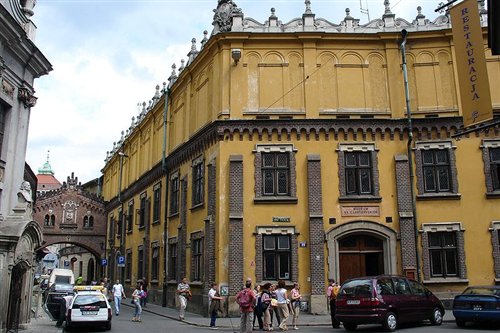
The Czartoryski Museum in Krakow
The museum, a miraculous survivor that has endured numerous occupations and a period in Parisian exile, is famed for its possession of Leonardo da Vinci’s Lady with an Ermine, whilst also boasting one of the country's most prized collections of Polish art and artefacts.
The prince’s dramatic decision was intended to end a stand-off with the National Museum. The latter took over the collections after World War II, and in 1991, following the fall of the Iron Curtain, a compromise was struck by which the National Museum continued to co-administer and co-fund the enterprise.
Nevertheless, a divorce appeared to be in the pipeline as tensions mounted over the last five years. However, last week’s move appeared to reverse this process.
The prince has declared that his aim is “to improve the functioning of the Foundation of the Czartoryski Princes and to assure the correct collaboration with the National Museum in Krakow.”
In so doing, he professed he was continuing “the mission” that had been “initiated by his ancestors in the service of the Nation.”
However, the outgoing board is flabbergasted, noting that earlier this month, the Council had unanimously voiced its approval of recent work.
Reconciliation or renationalisation?
Most prominent in last week’s rash of sackings was Count Adam Zamoyski, historian and hitherto Chairman of the Board of the Czartoryski Foundation. Zamoyski, a first cousin of Czartoryski (both grew up in exile) had set in motion a major revamp of the museum, and due to this, the building has been closed to the public for over a year.
In an interview with Polish Radio, Zamoyski professed astonishment that his cousin, who lives mainly in Spain and England, had “overnight reversed his and our policy for the last twenty years.”
He decried the new arrangements, which see members of staff from the National Museum taking up the entire new managerial board.
“In a sense, twenty years after the recovery of independence, what we’re seeing is almost a renationalisation of the one truly private collection in Poland... a two hundred year-old museum that had managed to keep its autonomy.”
One area in which the museum’s autonomy had been challenged over the last few years was in loans of the Leonardo masterpiece. Those against the loans note that the Mona Lisa never leaves the Louvre.
Although a series of loans of the painting – to Madrid, Berlin and London – was approved by the Ministry of Culture this year, allowing the Czartoryski family to raise funds for the museum’s ongoing revamp, Minister of Culture Bogdan Zdrojewski has said that he would like the ministry “to take a greater degree of responsibility, not only for that one picture, but for the entire collection.”
An initial agreement was struck this spring, restricting further loans of the Leonardo for a ten year period.
Meanwhile, Olga Jaros, a curator from the National Museum who has been appointed as the new chairman of the board, was at pains to downplay notions of renationalisation.
She stressed the long-running, legally-binding cooperation between the two institutions, and highlighted that the collections still very much belong to the Czartoryski family.
“I think it’s absolutely too early,” she said of notions of a reduction in the museum's autonomy.
“If there would be any concerns of this type, it’s definitely not the moment to raise them.”
Sections of the Polish press have highlighted a clash of personalities between Zamoyski and Zofia Golubiew, Director of the National Museum in Krakow.
Zamoyski had accused the National of passing down the museum in a poor state – an accusation vigorously denied by the latter.
Zamoyski did not win many friends in the local media, which bitterly opposed the loans of the da Vinci, and was suspicious about proposals to sell minor parts of the collection to raise money for the renovation.
Olga Jaros was unceasingly polite in her references to the outgoing board – acknowledging Zamoyski’s achievements as a historian – and stressed that above all, Prince Czartoryski’s “main concern” is “to reopen the museum as soon as possible.”
Indeed, it appears that concern about whether the revamp of the museum will meet deadlines is a key aspect in the current problems, thus prompting the prince – apparently somewhat in the dark about how the renovation was going – to seek help with the National Museum.
Zamoyski, who had managed the project as Chairman of the Foundation’s Board, had raised funds largely through the Norway Grants programme.
But it appears that large sums are still needed, with concrete deadlines looming.
“There are certain deadlines that are imposed on us, due to the fact that part of the renovation project is financed from Norwegian funds,” says Jaros, who has taken over the reins.
“So we have to keep these deadlines,” she underlines.
“Also, keeping in mind that the final deadline for construction work has already been postponed, then it’s absolutely the last deadline.
“By April 2012, all the construction work has to be finished.”
In the wake of last week’s changes, the director of the National Museum in Krakow, Zofia Golubiew, has already voiced her willingness to help achieve a timely completion of the project.
“If we are in a position to help, for example in conducting the renovation... we will certainly do so,” she declared.
Meanwhile, the outgoing board is compelled to accept that their project – the culmination of which Zamoyski had foreseen as “a world class event”, will be completed by other parties. (jb)